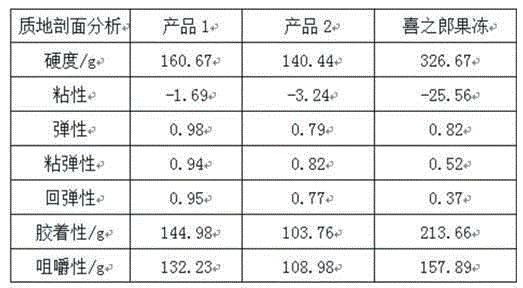Method for making pigskin collagen jelly
A pigskin collagen and pigskin technology, applied in the field of preparation of pigskin collagen jelly, can solve the problems of lack of gel texture and elasticity, low production efficiency, high energy consumption, etc., achieve excellent physical and biochemical properties, accelerate removal, energy-intensive effect
- Summary
- Abstract
- Description
- Claims
- Application Information
AI Technical Summary
Problems solved by technology
Method used
Image
Examples
Embodiment 1
[0031] Preparation of pork skin collagen jelly:
[0032] (1) Thawing: Soak the frozen pigskin with 5% saline for 30 minutes and remove it for later use; it can be thawed and remove salt-soluble protein and other soluble impurities;
[0033] (2) Pretreatment: Then marinate the pigskin with 2% ethanol and 5% acetic acid for 1 hour. The total amount of ethanol and acetic acid is 1.2 to 1.5 times the volume of the pig skin. Rinse the skin 3 times with warm water and cut into small pieces;
[0034] (3) Enzymatic hydrolysis: add 40 parts of pretreated pigskin to 200 parts of water, heat to 50-55°C, add 0.04 parts of papain, keep the temperature for 40-45 minutes, then add 0.04 parts of transglutaminase , kept at a constant temperature for 10-15 minutes to obtain the enzymatic hydrolysis solution;
[0035] (4) Cooking: heat up to 70-80°C and add 1.0 parts of salt, 0.8 parts of sugar, 0.6 parts of monosodium glutamate, 0.8 parts of ginger powder, 0.5 parts of pepper powder, 0.5 part...
Embodiment 2
[0041] Preparation of pork skin collagen jelly:
[0042] (1) Thawing: Soak the frozen pigskin with 5% saline for 30 minutes and remove it for later use; it can be thawed and remove salt-soluble protein and other soluble impurities;
[0043] (2) Pretreatment: Then marinate the pigskin with 2% ethanol and 5% acetic acid for 1 hour. The total amount of ethanol and acetic acid is 1.2 to 1.5 times the volume of the pig skin. Rinse the skin 3 times with warm water and cut into small pieces;
[0044] (3) Enzymolysis: Add 50 parts of pretreated pigskin to 250 parts of water, heat to 50-55°C, add 0.05 part of papain, keep the temperature for 40-45 minutes, then add 0.05 part of transglutaminase , kept at a constant temperature for 10-15 minutes to obtain the enzymatic hydrolysis solution;
[0045](4) Cooking: heat up to 70-80°C and add 1.2 parts of salt, 1.0 parts of sugar, 0.8 parts of monosodium glutamate, 1.0 parts of ginger powder, 0.7 parts of pepper powder, 0.7 parts of cinnamo...
Embodiment 3
[0051] Preparation of pork skin collagen jelly:
[0052] (1) Thawing: Soak the frozen pigskin with 5% saline for 30 minutes and remove it for later use; it can be thawed and remove salt-soluble protein and other soluble impurities;
[0053] (2) Pretreatment: Then marinate the pigskin with 2% ethanol and 5% acetic acid for 1 hour. The total amount of ethanol and acetic acid is 1.2 to 1.5 times the volume of the pig skin. Rinse the skin 3 times with warm water and cut into small pieces;
[0054] (3) Enzymolysis: Add 45 parts of pretreated pigskin to 225 parts of water, heat to 50-55°C, add 0.045 parts of papain, keep the temperature for 40-45 minutes, then add 0.04 parts of transglutaminase , kept at a constant temperature for 10-15 minutes to obtain the enzymatic hydrolysis solution;
[0055] (4) Boiling: heat up to 70-80°C and add 1.1 parts of salt, 0.9 parts of sugar, 0.7 parts of monosodium glutamate, 0.9 parts of ginger powder, 0.6 parts of pepper powder, 0.6 parts of cin...
PUM
 Login to View More
Login to View More Abstract
Description
Claims
Application Information
 Login to View More
Login to View More - R&D
- Intellectual Property
- Life Sciences
- Materials
- Tech Scout
- Unparalleled Data Quality
- Higher Quality Content
- 60% Fewer Hallucinations
Browse by: Latest US Patents, China's latest patents, Technical Efficacy Thesaurus, Application Domain, Technology Topic, Popular Technical Reports.
© 2025 PatSnap. All rights reserved.Legal|Privacy policy|Modern Slavery Act Transparency Statement|Sitemap|About US| Contact US: help@patsnap.com

